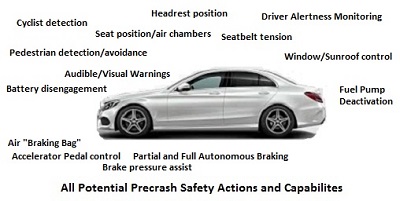Precrash Safety Systems
by Hamilton Gray, Clemson Electrical Engineering Student
- Basic Description
-
Precrash Safety Systems are designed to warn the driver in the event of a potential or unavoidable collision and respond in a combination of actions to prevent or reduce collision severity depending upon the driver’s reaction. Current Precrash Safety Systems vary widely between manufacturers; however, all systems maintain a basic set of actions that have been tested thoroughly in both development and real world situations to reduce collision severity as well as prevent collisions.
 Precrash Safety Systems use radar, laser, and/or image sensors to determine if there is a potential for a collision. Once detected, the system uses an audible and/or visual warning to alert the driver to react and prepare for the collision. Some systems work alongside Driver Alertness Monitoring and can issue the driver a warning based upon the driving style recorded in the initial minutes of driving. Basic systems react to the potential collision by tightening seatbelts, closing the windows and sunroof, adjusting seat/headrest positions, and increasing brake pressure to improve braking power and reduce the severity of the impact.
Precrash Safety Systems use radar, laser, and/or image sensors to determine if there is a potential for a collision. Once detected, the system uses an audible and/or visual warning to alert the driver to react and prepare for the collision. Some systems work alongside Driver Alertness Monitoring and can issue the driver a warning based upon the driving style recorded in the initial minutes of driving. Basic systems react to the potential collision by tightening seatbelts, closing the windows and sunroof, adjusting seat/headrest positions, and increasing brake pressure to improve braking power and reduce the severity of the impact.
As consumers increasingly desire safer vehicles, manufacturers have been competing in unique and innovative ways to insure top safety ratings while setting themselves apart from the rest. BMW’s safety system named “Advanced Safety Electronics” provides additional measures that include disengaging the car battery and deactivating the fuel pump based on the calculated potential severity of impact to reduce the danger of fire. Mazda employs acceleration control for some models with automatic transmissions in case of sudden accidental acceleration mistaken for braking in the event of an impending collision. Mercedes-Benz’s registered trademark “PRE-SAFE” includes Pedestrian Recognition, full Autonomous Emergency Braking, as well as air chambers that can raise seat bottoms and fill seat sides mimicking bucket seats to further limit occupant movement and forces during a collision. Mercedes-Benz has also developed an air “Braking Bag” on its S400 Hybrid model that deploys in the vehicle floor underneath the engine to increase friction and braking power as well as to prevent the front end from diving which can intensify a collision. While Precrash Safety Systems will continue to be improved and implemented in automobiles for good reason, all manufacturers have legal disclaimers that state these systems are not a substitute for safe and attentive driving nor detect all possible collisions.
- Sensors
- Radar, laser and/or image sensors, vehicle speed sensor, yaw sensor, acceleration sensor, accelerator pedal position, brake pressure sensor, brake pedal position, headrest position, seat position
- Actuators
- Throttle, brakes, window control, power seats, headrest control, seatbelt tensioner, air chamber/bag inflation device
- Data Communications
- Control Area Network (CAN) or FlexRay
- Manufacturers
- Audi/Bosch, BMW, Chrysler/Jeep, Denso, Ford, Honda, Hyundai, Lexus, Mazda, Mercedes-Benz, Nissan, Toyota, Volkswagen, Volvo
- For More Information
- [1] Collision Avoidance System, Wikipedia.
- [2] Mercedes-Benz ESF S400 Concept's "Braking Bag", Autoblog.com.
- [3] Mercedes-Benz TV: PRE-SAFE (R) Brake., YouTube, Sep. 2, 2013.
- [4] BMW Advanced Safety Electronics (ASE), BMW.com.
- [5] Nissan Predictive Forward Collision, YouTube, Dec. 1, 2011.
- [6] Honda Collision Mitigation Braking System, YouTube, Sep. 27, 2010.
- [7] Volvo unveils cyclist alert-and-brake car system, BBC.com.
- [8] Toyota Integrated Safety - Pre-collision System with Pedestrian-avoidance Steer Assist, YouTube, Oct. 11, 2013.
- [9] Advanced Pre-Collision System: The 2013 Lexus LS Innovation Series, YouTube, Oct. 29, 2012.
- [10] Audi Pre-Sense Basic system, YouTube, Dec. 3, 2012.
- [11] Avalon How-To: Pre-Collision System (PCS), YouTube, Jan. 28, 2013.
- [12] Ford Collision Warning System Explained at the Dearborn R&D Center, YouTube, Dec. 16, 2013.
- [13] 2015 Chrysler 200 Forward Collision Warning, YouTube, Apr. 29, 2014.
|

